Friday☕️

Trending:
- On October 2, 2025, a 35-year-old man named Jihad Al-Shamie, a Syrian immigrant who arrived in Britain at age six and later obtained citizenship, carried out an attack outside the Heaton Park Hebrew Congregation Synagogue in Manchester during Yom Kippur services. He drove a vehicle into a group of worshippers, then exited and stabbed several individuals, resulting in the deaths of two Jewish men and serious injuries to three others. Police responded to the scene and shot Al-Shamie dead; a fake explosive vest was discovered on his body, though it posed no actual threat.
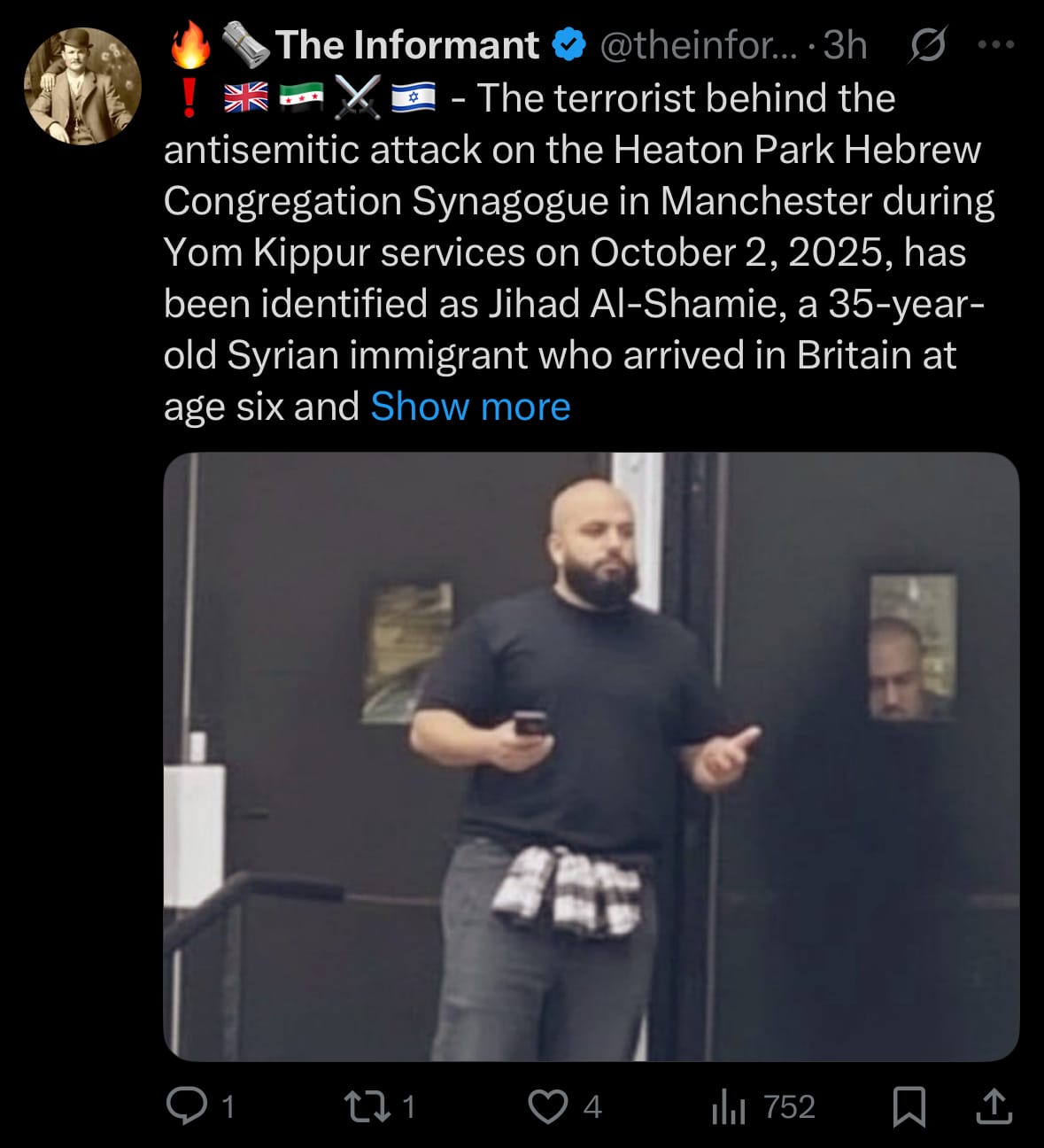
- Authorities classified the incident as a terrorist attack, prompting an investigation into potential motives and any accomplices, with three individuals taken into custody for questioning. The event occurred amid reports of increasing antisemitic incidents in the UK, leading to heightened security at Jewish sites and statements from community leaders expressing concerns over safety during religious observances. No group has claimed responsibility, and the probe continues to assess links to broader extremism.
Economics & Markets:
- Yesterday’s U.S. stock market:

- Yesterday’s commodity market:

- Yesterday’s crypto market:
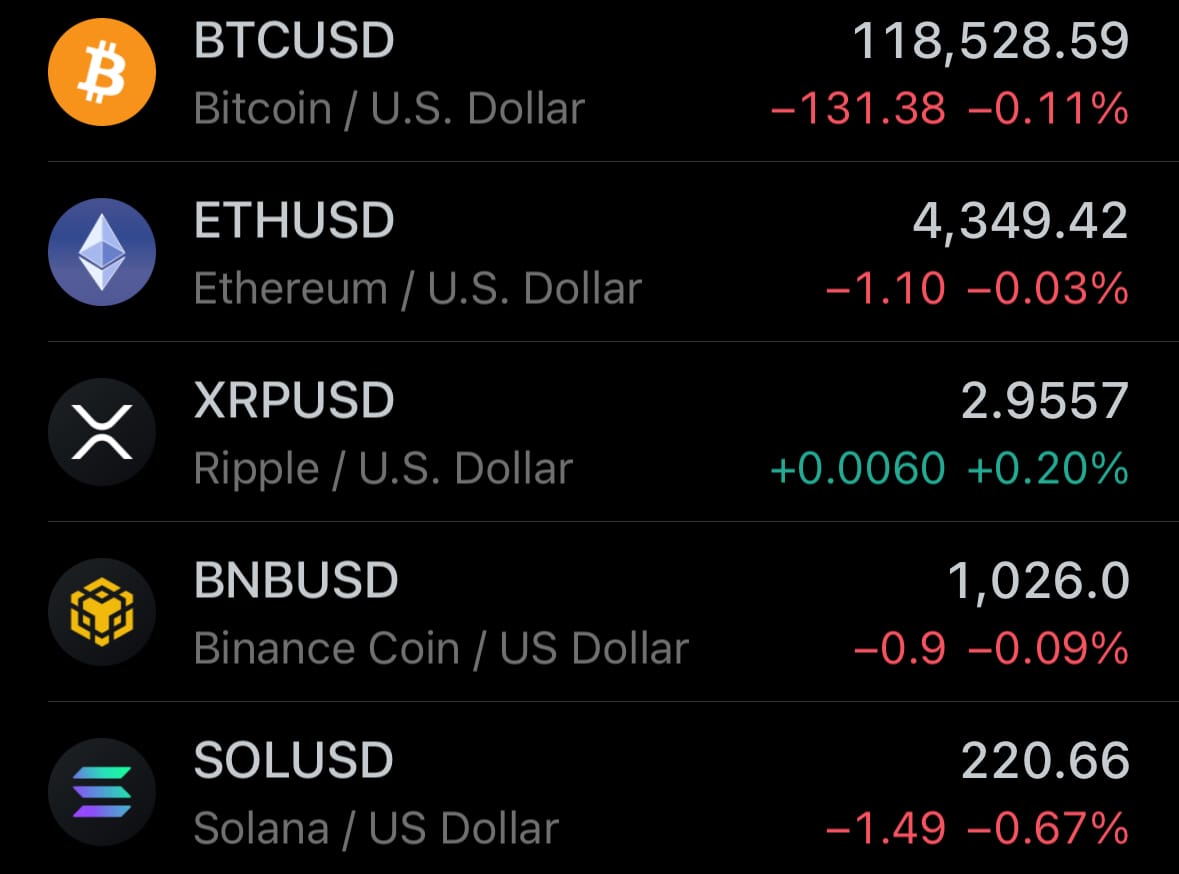
Geopolitics & Military Activity:
- On October 2, 2025, the Israel Defense Forces released a 24-hour operational recap for Yom Kippur, outlining incidents and responses in Gaza, southern Lebanon, and Judea and Samaria. In Gaza, five projectiles were fired from the north toward Israel, either intercepted or landing in open areas with no injuries reported, while IDF troops carried out operations in central Gaza. In southern Lebanon, Hezbollah members were killed in Israeli strikes. In Judea and Samaria, two people attempted a ramming and shooting attack on IDF troops at the Bell checkpoint near Jenin, resulting in one being killed and the other arrested, with no injuries to Israeli forces.

- In a 12-hour naval operation, the Israeli Navy stopped 41 vessels with over 400 people from various countries trying to enter Gaza's maritime zone to provide aid and supplies, redirecting them to Ashdod Port. The flotilla, organized by pro-Palestinian activists to provide humanitarian aid, was halted without resistance or injuries. The IDF described these actions as efforts to address security threats to civilians, amid ongoing regional tensions including Houthi activities and wider Middle East conflicts.

Environment & Weather:
- On October 2, 2025, a massive fire broke out in the afternoon at 1070 Piapi Boulevard in Barangay 21-C, Davao City, Philippines, escalating to a fourth alarm level due to its rapid spread through a densely populated residential area. The blaze, which started around 2 p.m. local time, destroyed over 400 homes, with some reports estimating up to 500 structures affected, primarily makeshift houses in the coastal community. Local barangay captain confirmed the extent of the damage, noting that strong winds and flammable materials contributed to the fire's intensity, leading to the displacement of hundreds of residents.
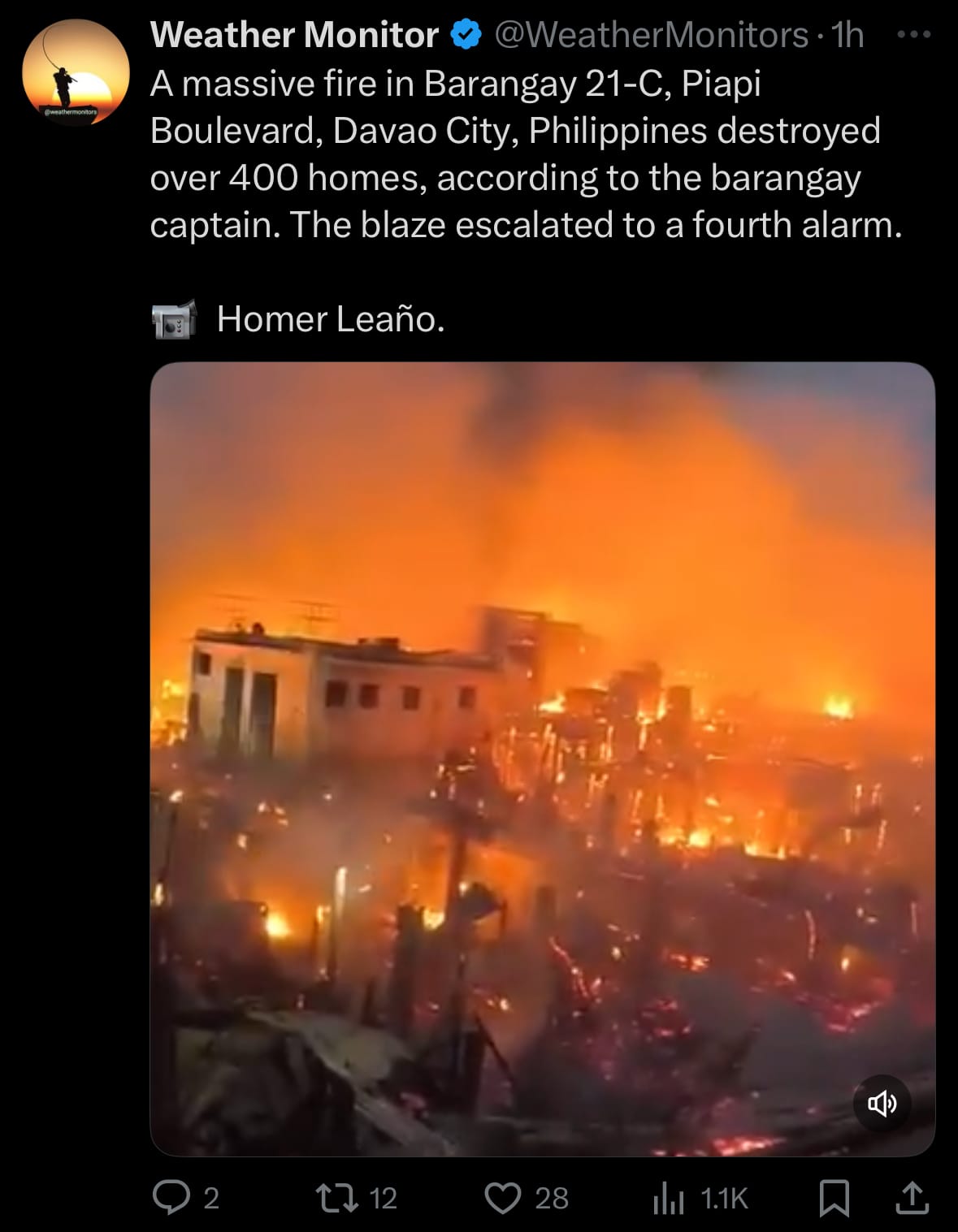
- The Bureau of Fire Protection responded with multiple fire trucks and personnel, declaring the fire under control by 5 p.m. and fully extinguished by 7:27 p.m., with no reported casualties or injuries. Evacuation efforts were coordinated by local authorities, directing affected families to temporary shelters in nearby schools and gyms, while investigations into the cause began immediately. The cause remains unknown.
Defense & Security:
- Last month, U.S.-defense contractor Epirus conducted a live-fire demonstration of its Leonidas high-power microwave anti-drone system at Camp Atterbury, Indiana, successfully disabling 49 drones in a single electromagnetic pulse during a swarm scenario. The event, part of five operational tests, resulted in the neutralization of all 61 drones across various flight paths, showcasing the system's ability to detect and engage targets from multiple directions using gallium-nitride semiconductors to generate modifiable microwave emissions for optimized disruption of electronics. No physical projectiles were used, highlighting the non-kinetic approach that avoids collateral damage from debris, with the upgraded Leonidas model offering double the range and power compared to prior versions.
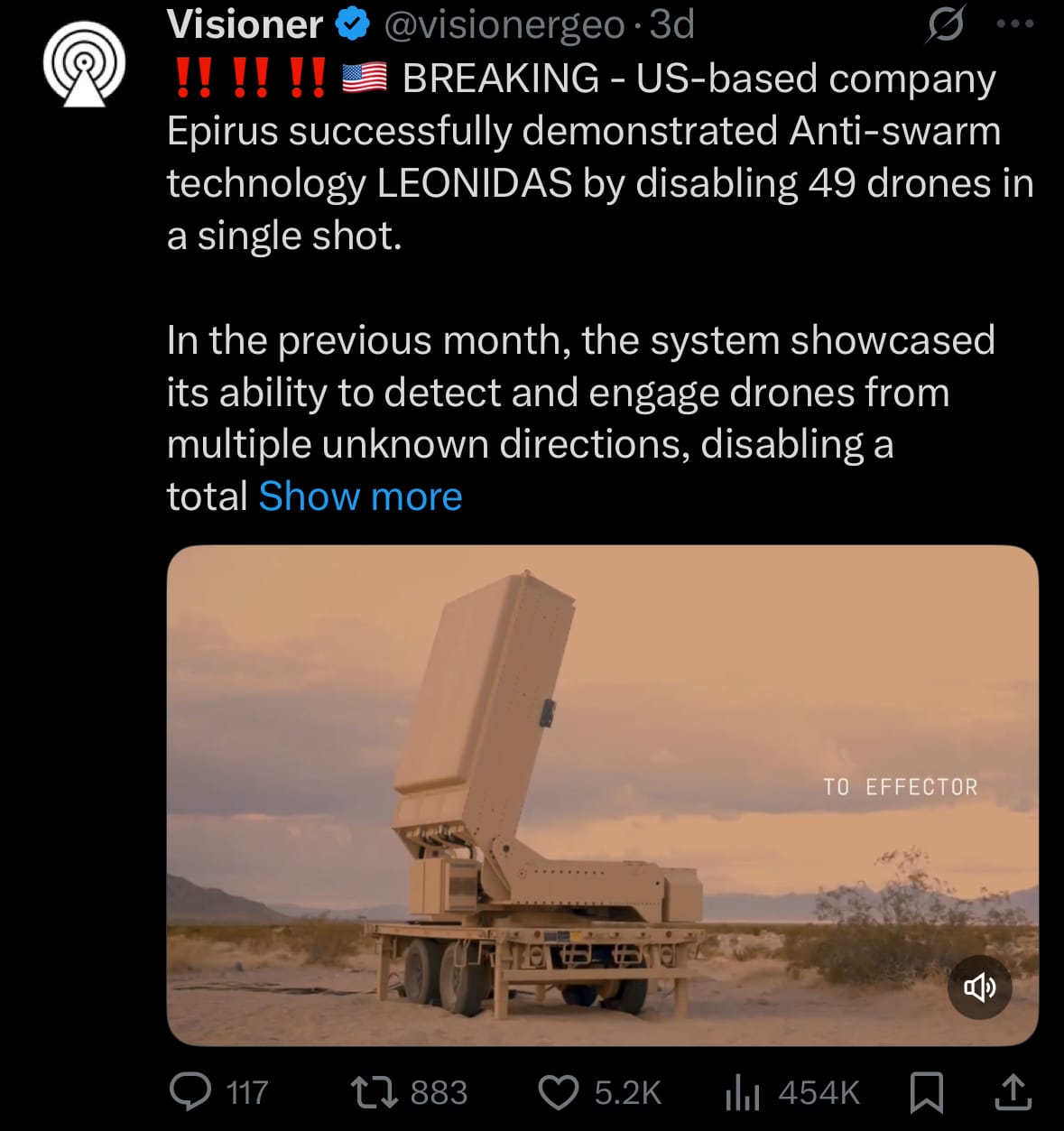
- This technology addresses the cost asymmetry in anti-drone warfare, where inexpensive drones favor attackers over traditional defenses like missiles, by providing a scalable, reusable solution similar to other directed-energy systems such as the U.S. Air Force's THOR, which also employs high-power microwaves for air base protection against swarms. Comparable electronic warfare platforms include Anduril's Pulsar family, an AI-driven system for jamming, geolocation, and threat disruption across modular configurations like vehicle-mounted or man-portable Pulsar-L variants, focusing on rapid adaptation to emerging threats without physical interception. Other anti-drone weaponry encompasses kinetic options like Raytheon's Coyote missiles for direct strikes, Rafael's Drone Dome for radar-guided jamming and laser neutralization, and net-based capture systems from companies like Dedrone, all aiming to balance defensive economics amid increasing drone proliferation in conflicts.
Statistic:
- Largest public telecommunications companies by market capitalization:
- 🇺🇸 T-Mobile US: $259.00B
- 🇨🇳 China Mobile: $238.35B
- 🇺🇸 AT&T: $193.13B
- 🇯🇵 SoftBank: $193.01B
- 🇺🇸 Verizon: $182.98B
- 🇩🇪 Deutsche Telekom: $167.27B
- 🇮🇳 Bharti Airtel: $126.34B
- 🇺🇸 Comcast: $112.24B
- 🇺🇸 American Tower: $89.51B
- 🇯🇵 NTT (Nippon Telegraph & Telephone): $86.68B
- 🇨🇳 China Telecom: $81.83B
- 🇲🇽 America Movil: $64.44B
- 🇯🇵 KDDI: $60.88B
- 🇸🇦 Saudi Telecom Company: $59.39B
- 🇸🇬 Singtel: $53.94B
- 🇦🇪 Emirates Telecom (Etisalat Group): $44.05B
- 🇫🇷 Orange: $42.50B
- 🇺🇸 Crown Castle: $41.56B
- 🇨🇭 Swisscom: $37.99B
- 🇺🇸 Charter Communications: $36.82B
- 🇦🇺 Telstra: $36.51B
- 🇭🇰 China Unicom: $34.99B
- 🇹🇼 Chunghwa Telecom: $33.87B
- 🇨🇳 ZTE: $29.37B
- 🇪🇸 Telefónica: $28.90B
History:
- The origins of fiber-optic communication stretch back to the 19th century, when John Tyndall demonstrated in 1854 that light could follow a curved path via internal reflection in water. This principle laid the groundwork for optical waveguides. In 1966, Charles K. Kao and George Hockham proposed that by reducing impurities in glass, light loss could be reduced to below 20 dB/km, making fiber-optic transmission viable. By 1970, Corning Glass Works achieved this milestone, producing ultra-pure silica fiber. Early deployments followed, and by 1977, the first commercial fiber-optic telephone system was operational in Long Beach, California. These systems combined lasers, modulators, photodetectors, and eventually erbium-doped fiber amplifiers to support long-haul transmission.
- The 1980s and 1990s saw fiber begin replacing copper in long-distance and submarine networks. In 1986, the first undersea fiber link (UK–Belgium No. 5) went into service, and in 1988, TAT-8—the first transatlantic fiber cable—connected the U.S., UK, and France with vastly higher capacity than legacy coaxial systems. Over the next decades, global fiber routes expanded with major submarine cables like SEA-ME-WE (Southeast Asia–Middle East–Western Europe), Southern Cross (Pacific), and others forming the modern internet backbone. Modern cables use Dense Wavelength-Division Multiplexing (DWDM), coherent optics, and space-division multiplexing (SDM), supporting tens of terabits per second per fiber pair. Google, Meta, Amazon, and Microsoft now fund and operate their own private or consortium-based cables, such as Grace Hopper (U.S. to Spain and UK) and Equiano (Europe to Africa), ensuring control over vast amounts of cloud and content traffic.
- Today, over 99% of all intercontinental data traffic moves via submarine fiber-optic cables, forming the critical infrastructure of the modern internet. On land, dense fiber networks crisscross North America, Europe, and Asia, linking cities, data centers, and wireless towers. In the U.S., fiber now passes more than 50% of homes and businesses, with about 17% of broadband users on fiber-to-the-home (FTTH) plans. In global urban centers, fiber is even more dominant. Technologies like reconfigurable optical add-drop multiplexers (ROADMs), coherent transceivers, and optical switching make today’s fiber networks fully dynamic and scalable. From its beginnings as a scientific curiosity, fiber-optic communication has become the invisible foundation of our digital world—carrying video calls, cloud computing, stock trades, AI workloads, and nearly every byte that crosses the globe.
Image of the day:

Articles:


Thanks for reading!
Earth is complicated, we make it simple.

Monitor the planet with our free Earth Watch Globe (Click image below to view):
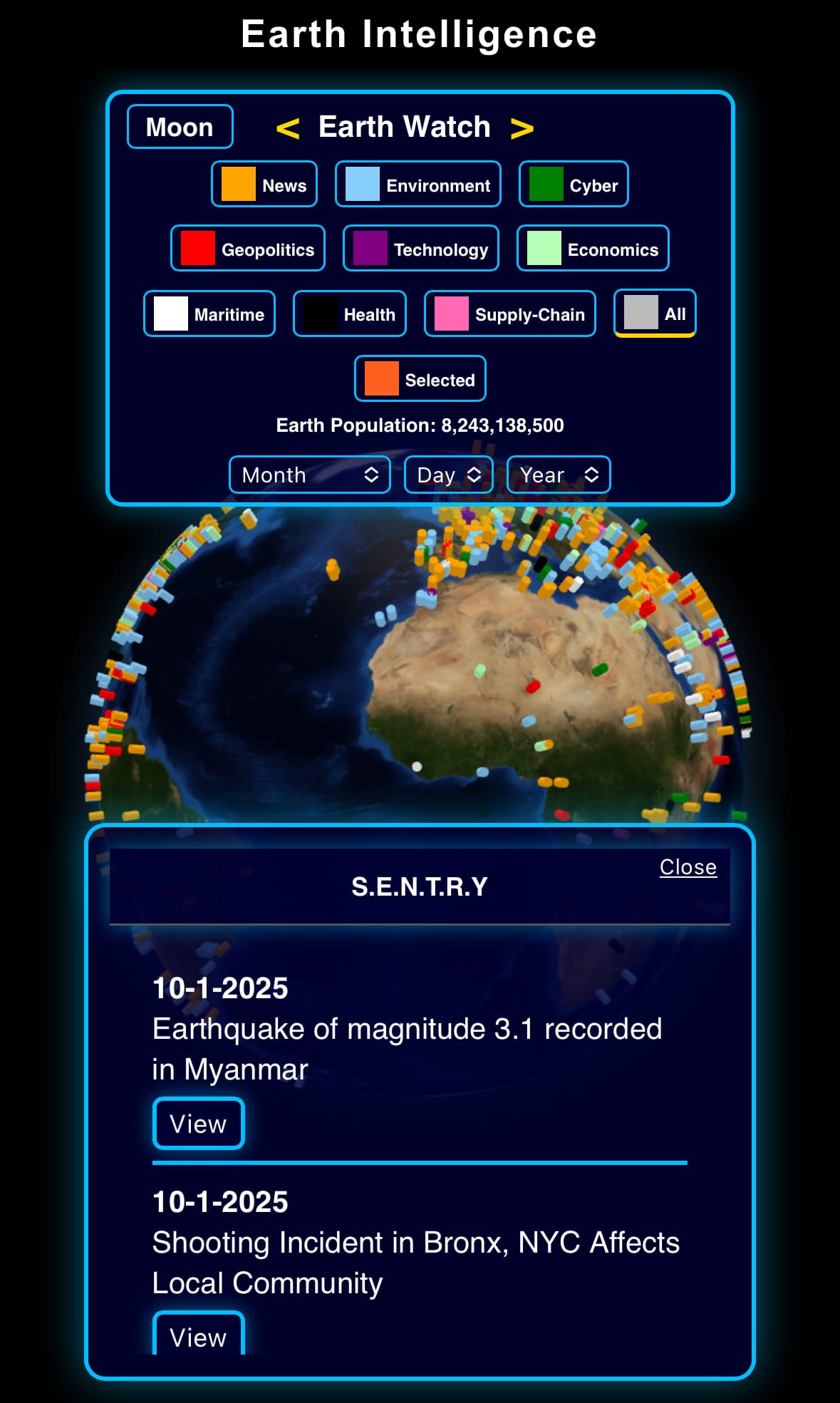
View our previous newsletters:

Support/Suggestions Email:
earthintelligence@earthintel.news




